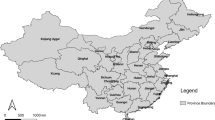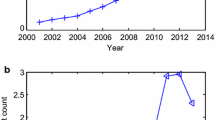Abstract
Absorptive capacity is viewed as a critical “moderator” in the process of knowledge creation, while inadequate focus has yet been directed to systematically inspect the role of regional absorptive capacity in shaping the geography of innovation. By incorporating the conceptual framework of absorptive capacity into regional innovation studies, this paper moves a step forward by re-evaluating the determinants behind regional innovation in the context of China, especially focusing on the moderating effect of regional absorptive capacity and its heterogeneity across cities. Empirically, this study first traces the spatiotemporal dynamics of innovation in China from 2000 to 2015 with the aid of a multi-scalar Markov chain analysis. Next, it unveils the extent to which regional absorptive capacity moderates the relationships between regional innovation and its major determinants by running a set of panel quantile regressions. Results uncover that regional absorptive capacity - especially for industrial R&D, government support and FDI, also proved as the most critical factors that facilitate regional innovation in China - is revealed only in highly innovative cities but not in less innovative ones. In this light, regional absorptive capacity in China unexpectedly serves as a self-reinforcing mechanism solely for highly innovative cities, which further advances the current understanding of the rising regional inequality of innovation in China.



Similar content being viewed by others
References
Acs, Z. J., Audretsch, D. B., & Feldman, M. P. (1994). R&D spillovers and innovative activity. Managerial and Decision Economics, 15(2), 131–138.
Acs, Z. J., Braunerhjelm, P., Audretsch, D. B., & Carlsson, B. (2009). The knowledge spillover theory of entrepreneurship. Small Business Economics, 32(1), 15–30.
Aghion, P., & Howitt, P. (1992). A model of growth through creative destruction. Econometrica: journal of the Econometric Society, 60(2), 323–352.
Audretsch, D. B., & Feldman, M. P. (1996). R&D spillovers and the geography of innovation and production. The American Economic Review, 86(3), 630–640.
Azagra-Caro, J. M., Archontakis, F., Gutiérrez-Gracia, A., & Fernández-de-Lucio, I. (2006). Faculty support for the objectives of university–industry relations versus degree of R&D cooperation: the importance of regional absorptive capacity. Research Policy, 35(1), 37–55.
Blomstrom, M., & Persson, H. (1983). Foreign investment and spillover efficiency in an underdeveloped economy: evidence from Mexican manufacturing industry. World Development, 11, 493–501.
Borensztein, E., De Gregorio, J., & Lee, J. W. (1998). How does foreign direct investment affect economic growth? Journal of International Economics, 45(1), 115–135.
Branstetter, L. G., & Sakakibara, M. (2002). When do research consortia work well and why? Evidence from Japanese panel data. American Economic Review, 92(1), 143–159.
Braunerhjelm, P., Acs, Z. J., Audretsch, D. B., & Carlsson, B. (2010). The missing link: knowledge diffusion and entrepreneurship in endogenous growth. Small Business Economics, 34(2), 105–125.
Camison, C., & Fores, B. (2010). Knowledge absorptive capacity: New insights for its conceptualization and measurement. Journal of Business Research, 63(7), 707–715.
Caragliu, A., & Nijkamp, P. (2008). The impact of regional absorptive capacity on spatial knowledge spillovers. Tinbergen Institute Discussion Paper.
Caragliu, A., & Nijkamp, P. (2012). The impact of regional absorptive capacity on spatial knowledge spillovers: the Cohen and Levinthal model revisited. Applied Economics, 44(11), 1363–1374.
Castaldi, C., Frenken, K., & Los, B. (2015). Related variety, unrelated variety and technological breakthroughs: an analysis of US state-level patenting. Regional Studies, 49(5), 767–781.
Cohen, W. M., & Levinthal, D. A. (1990). Absorptive capacity: a new perspective on learning and innovation. Administrative Science Quarterly, 35(1), 128–152.
Czarnitzki, D., & Hussinger, K. (2004). The link between R&D subsidies, R&D spending and technological performance. ZEW - Centre for European Economic Research.
Driffield, N., & Munday, M. (2001). Foreign manufacturing, regional agglomeration and technical efficiency in UK industries: a stochastic production frontier approach. Regional Studies, 35(5), 391–399.
Fores, B., & Camison, C. (2011). The complementary effect of internal learning capacity and absorptive capacity on performance: the mediating role of innovation capacity. International Journal of Technology Management, 55(1/2), 56–81.
Fu, X. (2008). Foreign direct investment, absorptive capacity and regional innovation capabilities: evidence from China. Oxford Development Studies, 36(1), 89–110.
Gao, S., Xu, K., & Yang, J. (2008). Managerial ties, absorptive capacity, and innovation. Asia Pacific Journal of Management, 25(3), 395–412.
Giuliani, E. (2005). Cluster absorptive capacity - why do some clusters forge ahead and others lag behind? European Urban and Regional Studies, 12(3), 269–288.
Glaeser, E. L., Kallal, H. D., Scheinkman, J. A., & Shleifer, A. (1992). Growth in cities. Journal of Political Economy, 100(6), 1126–1152.
Grossman, G. M., & Helpman, E. (1991). Quality ladders in the theory of growth. The Review of Economic Studies, 58(1), 43–61.
Guellec, D., & Van Pottelsberghe De La Potterie, B. (2003). The impact of public R&D expenditure on business R&D. Economics of Innovation and New Technology, 12(3), 225–243.
Haddad, M., & Harrison, A. (1993). Are there positive spillovers from direct foreign investment?: evidence from panel data for Morocco. Journal of Development Economics, 42(1), 51–74.
Harrison, A. (1999). Do domestic firms benefit from foreign direct investment? Evidence from Venezuela. American Economic Review, 89(3), 605–618..
He, S., Fang, C., & Zhang, W. (2017). A geospatial analysis of multi-scalar regional inequality in China and in metropolitan regions. Applied Geography, 88, 199–212.
Jacobs, J. (1969). The economy of cities. New York: Vintage.
Jung, J., & Lopez-Bazo, E. (2017). Factor accumulation, externalities, and absorptive capacity in regional growth: evidence from Europe. Journal of Regional Science, 57(2), 266–289.
Kallio, A., Harmaakorpi, V., & Pihkala, T. (2010). Absorptive capacity and social Capital in Regional Innovation Systems: The case of the Lahti region in Finland. Urban Studies, 47(2), 303–319.
Keller, W. (1996). Absorptive capacity: on the creation and acquisition of technology in development. Journal of Development Economics, 49(1), 199–227.
Knockaert, M., Spithoven, A., & Clarysse, B. (2014). The impact of technology intermediaries on firm cognitive capacity additionality. Technological Forecasting and Social Change, 81, 376–387.
Koenker, R. (2004). Quantile regression for longitudinal data. Journal of Multivariate Analysis, 91(1), 74–89.
Koenker, R., & Bassett, G., Jr. (1978). Regression quantiles. Econometrica: Journal of the Econometric Society, 46, 33–50.
Koenker, R., & Hallock, K. F. (2001). Quantile regression. Journal of Economic Perspectives, 15(4), 143–156.
Lane, P. J., & Lubatkin, M. (1998). Relative absorptive capacity and interorganizational learning. Strategic Management Journal, 19(5), 461–477.
Liao, F. H. F., & Wei, Y. D. (2012). Dynamics, space, and regional inequality in provincial China: a case study of Guangdong province. Applied Geography, 35(1), 71–83.
Lichtenberg, F. R. (1984). The relationship between Federal Contract R&D and Company R&D. The American Economic Review, 74(2), 73–78.
Liu, Y., & Shen, J. (2017). Modelling skilled and less-skilled interregional migrations in China, 2000–2005. Population, Space and Place, 23(4), e2027.
Liu, X., & White, R. S. (1997). The relative contributions of foreign technology and domestic inputs to innovation in Chinese manufacturing industries. Technovation, 17(3), 119–125.
Liu, Y., Shen, J., Xu, W., & Wang, G. (2017). From school to university to work: migration of highly educated youths in China. [journal article. The Annals of Regional Science, 59(3), 651–676.
Lund Vinding, A. (2006). Absorptive capacity and innovative performance: a human capital approach. Economics of Innovation and New Technology, 15(4–5), 507–517.
Mowery, D. C., & Oxley, J. E. (1995). Inward technology transfer and competitiveness: the role of national innovation systems. Cambridge Journal of Economics, 19(1), 67–93.
Muscio, A. (2007). The impact of absorptive capacity on SMEs' collaboration. Economics of Innovation and New Technology, 16(8), 653–668.
Pred, A. (1977). City systems in advanced economies. London: Hutchinson.
Qian, H. F., & Acs, Z. J. (2013). An absorptive capacity theory of knowledge spillover entrepreneurship. Small Business Economics, 40(2), 185–197.
Qian, H. F., & Jung, H. J. (2017). Solving the knowledge filter puzzle: absorptive capacity, entrepreneurship and regional development. Small Business Economics, 48(1), 99–114.
Roper, S., & Love, J. H. (2006). Innovation and regional absorptive capacity: the labour market dimension. Annals of Regional Science, 40(2), 437–447.
Saito, H., & Gopinath, M. (2011). Knowledge spillovers, absorptive capacity, and skill intensity of Chilean manufacturing plants. Journal of Regional Science, 51(1), 83–101.
Spithoven, A., Clarysse, B., & Knockaert, M. (2010). Building absorptive capacity to organise inbound open innovation in traditional industries. Technovation, 30(2), 130–141.
Sun, Y. (2000). Spatial distribution of patents in China. Regional Studies, 34(5), 441–454.
UNESCO. (2018). How much does your country invest in R&D? UNESCO Institute for Statistics. (2018). http://uis.unesco.org/apps/visualisations/research-and-development-spending/. Accessed 15 July 2018.
Veugelers, R. (1997). Internal R&D expenditures and external technology sourcing. Research Policy, 26(3), 303–315.
Wallsten, S. J. (2000). The effects of government-industry R&D programs on private R&D: the case of the Small Business Innovation Research program. The Rand Journal of Economics, 31, 82–100.
Wei, Y. D., Yuan, F., & Liao, H. (2013). Spatial mismatch and determinants of foreign and domestic information and communication technology firms in urban China. The Professional Geographer, 65(2), 247–264.
Yang, C. H., & Lin, H. L. (2012). Openness, absorptive capacity, and regional innovation in China. Environment and Planning A, 44(2), 333–355.
Zahra, S. A., & George, G. (2002). Absorptive capacity: a review, reconceptualization, and extension. Academy of Management Review, 27(2), 185–203.
Funding
This work was supported by the National Natural Science (grant numbers 41871140 and 41501151) and the Program for Guangdong Introducing Innovative and Enterpreneurial Teams (grant number 2017ZT07X355).
Author information
Authors and Affiliations
Corresponding author
Ethics declarations
Conflict of Interest
The authors declare that they have no conflict of interest.
Additional information
Publisher’s Note
Springer Nature remains neutral with regard to jurisdictional claims in published maps and institutional affiliations.
Rights and permissions
About this article
Cite this article
Zeng, J., Liu, Y., Wang, R. et al. Absorptive Capacity and Regional Innovation in China: an Analysis of Patent Applications, 2000–2015. Appl. Spatial Analysis 12, 1031–1049 (2019). https://doi.org/10.1007/s12061-019-09300-y
Received:
Accepted:
Published:
Issue Date:
DOI: https://doi.org/10.1007/s12061-019-09300-y




